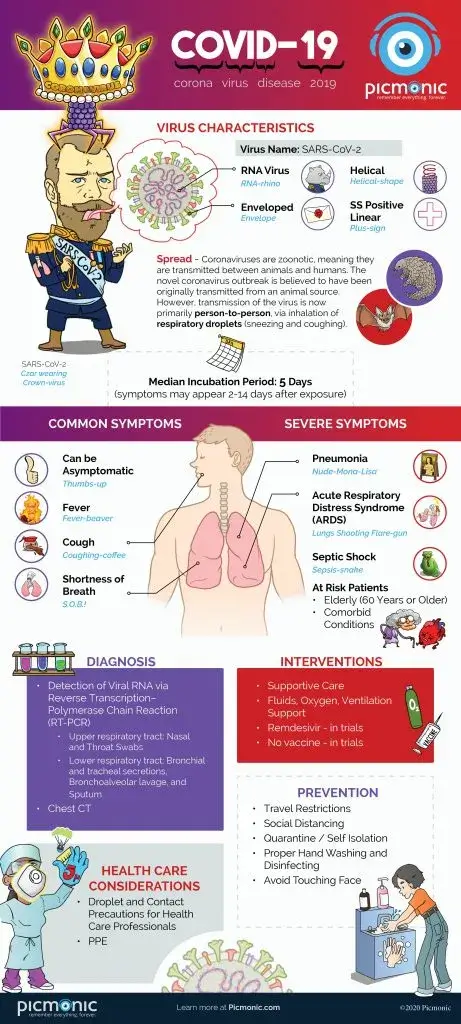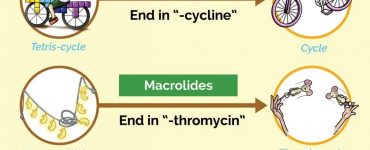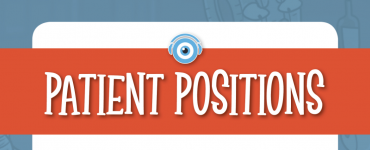It’s so important to stay informed these days, and therefore safe! We made a helpful infographic about COVID-19, the disease caused by the novel coronavirus. How did it originate? What are the symptoms? Is there anything we can do to lessen its spread? This infographic breaks it all down! Feel free to print it out and post it where ever it might be helpful!
*As new information from accredited sources is becoming available on a daily basis, this content is not guaranteed to be complete or up-to-date.

COVID-19 is a disease caused by an infection of the SARS-CoV-2 virus, which is a new strain of coronavirus that became known to medical professionals in late 2019. As a zoonotic virus, it is believed that it was originally transmitted from an animal source. However, this novel coronavirus is now transmitted primarily person-to-person via respiratory droplets.
Once infected, patients may experience fever, cough and shortness of breath. In severe cases, pneumonia, acute respiratory distress syndrome (ARDS), and septic shock can be seen. Elderly patients and those with comorbid conditions are more at risk for severe symptoms and death.
With the virus spreading across the globe, SARS-CoV-2 has become the source of the first pandemic since the 2009 H1N1 pandemic (H1N1pdm09 virus). Because of this, people are urged to take preventative measures such as restricting travel, practicing social distancing, self quarantining, and instituting proper hand washing and disinfecting.
As of March 19, 2020, there is no vaccine or cure; however, a vaccine is currently in trials. In addition, a novel antiviral drug named Remdesivir is currently in trials and the FDA has approved hydroxychloroquine testing as a possible intervention for COVID-19.
For other helpful information on COVID-19:
Study Resources:
Other resources:
- School closure statuses
- Johns Hopkins Resource Center
- University of Michigan Coronavirus Information and Updates
You can also view our Coronavirus Mnemonic Video and Quiz Questions for FREE:

At Picmonic, we’re doing everything we can to support students and educators during this challenging time. If there’s anything we can do to help you, please reach out to our team!
Want access to 1000+ other topics and free resources for students? We’ve got you covered.
References:
Al-Tawfiq, J. A., Al-Homoud, A. H., & Memish, Z. A. (in press). Remdesivir as a possible therapeutic option for COVID-19. Travel Medicine and Infectious Disease. https://web-b-ebscohost-com.proxy.missouristate.edu/ehost/detail/detail?vid=4&sid=f318c681-badd-498e-bffc-37604be04da5%40sessionmgr102&bdata=JnNpdGU9ZWhvc3QtbGl2ZSZzY29wZT1zaXRl#AN=32145386&db=cmedm
Cryanoski, D. (2020, March 5). Mystery deepens over animal source of coronavirus. Nature, 579, 18-19. https://doi.org/10.1038/d41586-020-00548-w
Osmosis https://www.osmosis.org/learn/COVID-19_(Coronavirus_Disease_19)
CDC. (Last reviewed March 10, 2020). Interim infection prevention and control recommendations. https://www.cdc.gov/coronavirus/2019-ncov/infection-control/control-recommendations.html?CDC_AA_refVal=https%3A%2F%2Fwww.cdc.gov%2Fcoronavirus%2F2019-ncov%2Fhcp%2Finfection-control.html
CDC. (Last reviewed March 11, 2020). Should I travel within the U.S.? https://www.cdc.gov/coronavirus/2019-ncov/travelers/travel-in-the-us.html
CDC. (Last Reviewed March 16, 2020). Travel. Retrieved from https://www.cdc.gov/coronavirus/2019-ncov/travelers/index.html
CDC. (March 4, 2020). Criteria to guide evaluation and laboratory testing for COVID-19. https://www.cdc.gov/coronavirus/2019-ncov/hcp/clinical-criteria.html?CDC_AA_refVal=https%3A%2F%2Fwww.cdc.gov%2Fcoronavirus%2F2019-ncov%2Fclinical-criteria.html
World Health Organization (WHO). Coronavirus disease (COVID-19) Pandemic https://www.who.int/emergencies/diseases/novel-coronavirus-2019
CDC. Information for Clinicians on Therapeutic Options for COVID-19 Patients
https://www.cdc.gov/coronavirus/2019-ncov/hcp/therapeutic-options.html













